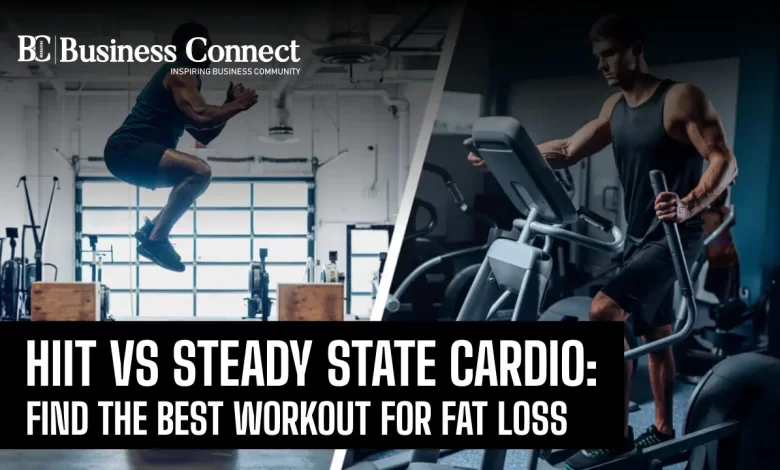HIIT Vs Steady State Cardio: Find The Best Workout For Fat Loss

HIIT vs Steady State Cardio: Find the best workout for fat loss
When it comes to fat loss, choosing the right type of workout is the key in order to achieve your goal efficiently and effectively. The most popular cardio exercises for fat loss are high intensity interval training and steady state cardio. Both of these cardio exercises are helpful to burn fat but they differ significantly in the way they work and offer.
In this blog, we will discuss the benefits, challenges and difference between height intensity interval training and steady state cardio to find out the best workout for fat loss.
Understanding steady state cardio
Steady state cardio is a kind of cardiovascular exercise in which activities are performed at a constant and moderate intensity for a prolonged period of time. Some of the key examples of this exercise include cycling, swimming, jogging and rowing. These exercises are done for a longer duration in comparison to HIIT. If you wish, you can maintain it to half to one hour longer. It is considered as ideal for those individuals who are aiming for steady fat loss. This cardiovascular exercise allows the body to gradually burn calorie and use the fat as a primary energy source.
Benefits of steady state cardio
- Since this cardiovascular exercise is performed with a moderate intensity, it can be performed by individuals for longer period of time which makes this exercise easier to commit.
- During this exercise, human body primarily uses fat as a fuel in order to reach a certain duration. This makes steady state cardio highly recommended for fat loss.
- The steady state exercises have lower impact on the joints which makes it suitable for individuals with injuries. It is even simple for those individuals who want to perform gentler workouts.
- This cardiovascular exercise allows individuals to establish a consistent exercise routine. It can enhance your fat loss journey if you will combine it with a balanced diet.
Drawbacks of Steady State Cardio
- Steady state cardio requires long durations typically 30 to 60 minutes or even more if you want to see significant benefits. This criterion makes it time consuming when we compare it to its alternatives.
- One such drawback is the plateau effect. Over a period of time, your body gets used to the rigorous exercise. After a certain duration, you will be required to constantly increase the duration and the intensity of the exercise if you want to see the significant result.
- Though it burns calorie but it is not as efficient as higher intensity workout.
Understanding high intensity interval training (HIIT)
High intensity interval training is a type of cardiovascular exercise in which a person performs intense exercise and then take a rest for a while. It is performed for 15 to 30 minutes which makes it shorter than steady state cardio. While performing intense exercise, the body push itself to work at its high capacity which is followed by short recovery periods. This exercise is designed in such a manner in which the body pushes the cardiovascular system to a certain limit which boost the anaerobic and aerobic fitness. Some of the common example of high intensity interval training workouts include sprints, circuit training, burpees, jump squats and mountain climbing.
Benefits of high intensity interval training
- This exercise is performed for a shortened duration of time in which you can burn a significant amount of calorie in a fraction of time.
- While performing this exercise, the body continues to burn calories at maximum rate for hours even after the workout is over. The afterburn effect makes this exercise highly effective for fat loss.
- Performing these workouts increases metabolism of the body as these exercises are highly intense in nature and it can promote fat loss even after the workout ends.
- In many of the researches, it is found out that these exercises are quite effective than moderate intensity exercise if you want to improve your heart health and enhance overall endurance capacity of the body.
- High intensity interval training includes body weight exercises and strength training movement which helps to preserve muscle mass while focusing on fat loss.
Drawbacks of intensity interval training
- The high intensity exercises are not suitable for beginners or those individuals who have injuries as it can put a strain on muscles and joints.
- By consistently following an intense exercise, your body will get tired especially if you are performing the exercise too often without adequate recovery.
- There is also a higher risk of overtraining and burnout if these exercises are not properly balanced with your rest days.
HIIT Versus steady state cardio: Which one is better for fat loss?
Though both high intensity interval training and steady state cardio is effective for fat burn but the fat is loosed in different ways in both of these exercises.
- Fat burning potential: In steady state cardio, the body uses fat as a fuel for energy when you walk out longer than 30 minutes. The rate of fat burning is moderate and the total calorie burn over a longer period of time is relatively modest when compared to high intensity workout. On the contrary, high intensity interval training burns more calories in less time. It even burns fat post workout due to its excess post exercise oxygen consumption. The intensity of this workout doesn’t completely rely on fat as an energy source. The overall fat loss journey can become more significant due to the afterburn effect.
- Time commitment: The steady state cardio requires a significant time investment if you want to achieve substantial fat loss. It will need at least 30 to 60 minutes. On the contrary, high intensity interval training workouts are comparatively shorter and typically lasts between 15 to 30 minutes. It is an excellent choice for those individuals who want to lose fat in a short interval of time using high intensity exercises.
- Muscle preservation: When the steady state cardio is performed for a long period of time, then it can lead to muscle loss as the body might burn muscle tissue for energy once glycogen stores are depleted. On the other hand, high intensity interval training workouts are designed in such a manner that it promotes fat loss while preserving and building lean muscle mass. The inclusion of body weight exercises and strength movements in this cardiovascular exercise helps to maintain muscle while burning fat.
- Intensity and sustainability: Steady state cardio’s are easier to maintain over a long term as it is of moderate intensity. It can be done regularly without significant fatigue as it consumes less time. On the contrary, HIIT is difficult to sustain daily without the rest. It is recommended to perform two to three times a week in order to avoid injury.
Instead of choosing one over another, many fitness experts recommended to combine both high intensity interval training and steady state cardio in your workout sessions to see the desired output. You can perform high intensity workout two to three times a week in order to get the benefit of intense calorie burn and fat loss while using steady state cardio on alternate days for fat oxidation and active recovery. This balanced approach will allow you to get the benefit of both workouts and minimizing the drawbacks.
Conclusion
Both high intensity interval training and steady state cardio have their own advantages when it comes to fat loss. The choice completely depends on preference, time availability and fitness level. By understanding the pros and cons of both cardiovascular workouts, you can decide which will cater to your preferences.






